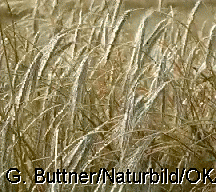
| |
 |
![]()
 Copyright 1997 Alan T. Hagan. All rights reserved.
Copyright 1997 Alan T. Hagan. All rights reserved.
Republished in part by express permission. Please note Disclaimer below.
Entire text also available as an ftp download.
Rye is a well known bread grain in this country, though not as popular as wheat. It has dark brown kernels longer and thinner than wheat, but less gluten. Bread made from this grain tends to be somewhat dense unless gluten is added (often in the form of a lot of wheat flour) with color that ranges from pale to dark brown. German pumpernickel, made with unrefined rye flour and molasses, is the blackest, densest form. Rye makes for excellent variety in the diet.
What I am about to say in the following is for those who may be interested in buying field run rye straight from the producer or distributor before it has been cleaned. If you purchase your rye from a food store after it has been cleaned, it is not much of a concern.
There is a fungal infection of grain called "ergot". It is attracted to rye more so than other grains, particularly if the growing conditions were damp where it was grown. This fungus causes a nervous disorder known as St. Anthony's fire. When eaten in large quantities the ergot alkaloids can cause constriction of the blood vessels, particularly in the extremities. The effects of ergot poisoning are cumulative and lead to numbness of the limbs and other, frequently serious symptoms.
The fungal disease affects only the flowering parts of many members of the grass family. The fungus bodies are hard, spur like, purple black structures that replace the kernel in the grain head. The ergot bodies can vary in size from the length of the kernel to as much as several times as long. They don't crush as easily as smut bodies of other funguses. When they are cracked open, the inner broken faces can be off-white, yellow, or tan. The infected grain looks very different from ordinary, healthy rye grains and can be spotted easily. Ergot only rarely affects other grains. If you purchase field run rye, you should closely examine it first for the presence of ergot bodies. If you find more than a very few, pass up that grain and look elsewhere.
DISCLAIMER: Safe and effective food storage requires attention to detail and proper equipment and ingredients. The author makes no warranties and assumes no responsibility for errors or omissions in the text, or damages resulting from the use or misuse of information contained herein. Placement of or access to this work on this or any other site does not mean the author espouses or adopts any political, philosophical or meta-physical concepts that may also be expressed wherever this work appears.